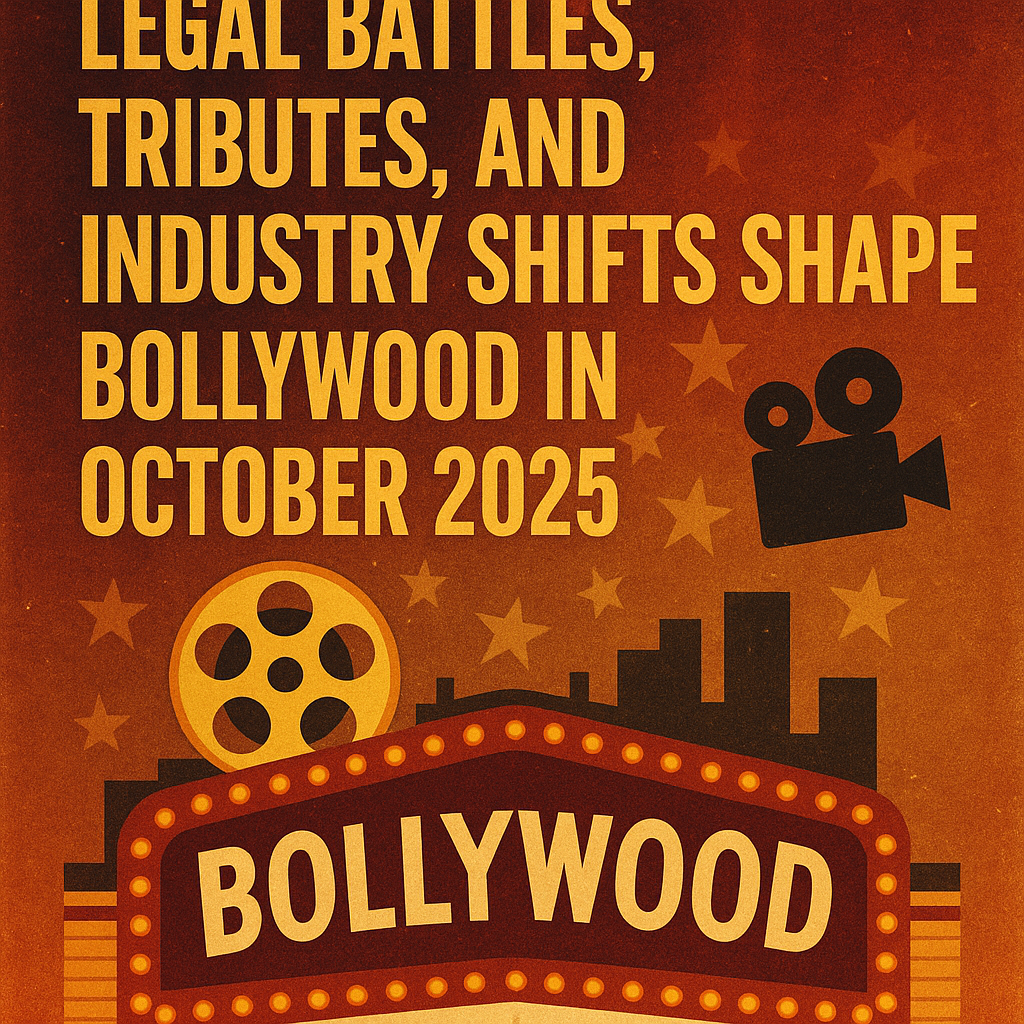TV & MOVIES
The Rise of OTT as the New Box Office

The Rise of OTT as the New Box Office
Once viewed as an alternative platform for offbeat cinema, OTT streaming has now become the new box office. Services like Netflix, Amazon Prime Video, Disney+ Hotstar, and JioCinema have blurred the lines between traditional film releases and digital premieres. Films now transition from theatre to streaming in record time, capitalizing on binge-hungry audiences. For stars, producers, and even entertainment journalists, success metrics have changed — viewership minutes are replacing weekend grosses. The result: OTT sits at the center of India’s entertainment economy, steering ad spends, influencing production budgets, and shaping the stories greenlit each quarter.
Entertainment News in the Age of Instant Streaming
In the digital ecosystem, entertainment journalism has transformed from the red carpet to the real-time feed. Every Friday now brings not just a theatrical release but multiple digital premieres across languages. Reporters have pivoted from set visits to decoding content strategy and from star gossip to viewership data. The new buzzwords: streaming engagement, AI-driven recommendations, and cross-platform visibility. Newsrooms like LiveNewsVault Entertainment and partners at CarryOnHarry now run OTT review dashboards, instant alerts, and trend explainers as core products.
Regional Powerhouses Take the Lead
India’s OTT revolution is inherently multilingual. Regional industries — Tamil, Telugu, Malayalam, Bengali, and Marathi — are not secondary players but growth engines. Breakout series and films prove that strong storytelling transcends language; national audiences discover talent via dubs, subs, and algorithmic curation. As fame democratizes, coverage widens: interviews and reviews from Kochi to Kolkata now trend pan-India within hours.
From Red Carpets to Reels: Celebrity PR Gets a Digital Makeover
Public relations and celebrity branding have undergone a dramatic shift. Actors cultivate fan engagement through behind-the-scenes reels, live Q&As, and platform-native collaborations. Reporters have become hybrid creators — part journalist, part analyst. Innovative campaigns (password-gated “secret reels,” ARG-style teasers, fan-first premieres) show how marketing has evolved for the scroll era: faster, smarter, and multimedia-first.
The Future: Where Algorithms Meet Art
As AI-driven curation becomes integral to discovery, the future of entertainment news is personalization. Editors increasingly collaborate with analytics to predict which categories — crime thriller, social drama, or period biopic — will surge. Independent desks leverage similar tools to deliver hyper-personalized reviews, streaming alerts, and creator spotlights tailored to micro-audiences. The story no longer ends at the screen; it continues in how we cover the screen.
Conclusion: The Digital Stage Expands
OTT has reinvented both entertainment and journalism. What used to be a Friday column is now a seven-day newsroom linking creators, audiences, and platforms through one digital thread. The future of entertainment news is streaming-first, global-minded, and endlessly connected. The screens may be smaller — the stories are larger than ever.
TV & MOVIES
Bollywood’s British Leap: Cross‑Border Filming and the New Cinematic Frontier

Bollywood’s British Leap: Cross‑Border Filming and the New Cinematic Frontier
Behind this move lie incentives, economic strategy, and symbolic ambition. The question now: can Bollywood transplant its cinematic heart without losing its cultural soul?
The announcement came via the corridors of power: British Prime Minister Keir Starmer revealed during his India visit that three Bollywood productions will be made in Britain from early 2026.
Central to the pact is Yash Raj Films, which had paused major UK shoots for eight years, now returning as the anchor for this cross‑border experiment.
Expected to generate around 3,000 jobs, the deal is as much diplomatic optics as industrial infrastructure.For Bollywood observers, it is a litmus test: can Indian storytelling adapt to foreign soil without feeling foreign?
The Vanguard: Yash Raj Leads the Charge
Yash Raj Films (YRF), long a stalwart of big‑scale Hindi cinema, is the first name attached to this UK dream.With its track record of lavish musicals, romance, and action — from Dilwale Dulhania Le Jayenge to Pathaan — YRF carries both brand capital and creative weight.Their reentry into Britain marks more than nostalgia: it signals a strategic pivot toward outward expansion.
But leading this frontier is no easy role. They will need to balance spectacle and intimacy, and reconcile Indian aesthetics with British logistical realities.
Incentives, Co‑Productions & Tax Mechanics
The financial architecture is critical. As part of the agreement, Indian and UK bodies will pursue co‑production treaties, resource sharing accords, and reciprocal benefits.UK’s creative industries already contribute around £12 billion annually and support ~90,000 jobs — the British case is that international shoots strengthen local ecosystems.Rebates, studio partnerships (e.g. Pinewood, Elstree) and infrastructure support are expected to sweeten the deal.But the devil is in execution: permissions, union rules, import logistics, film quotas, and cross‑border revenue sharing could complicate creative freedom.
Opportunities (and Tensions) for UK Crews & Cultural Exchange
Locally, film professionals in the UK see a surge of opportunity: from lighting crews to VFX houses, from set construction to post‑production houses. The promise of roughly 3,000 new roles is a significant magnet.Yet the collaboration demands sensitivity: will Indian team leads integrate, or default to bringing crews from India? Will local talent be collaborators or footnotes?
There is also the cultural friction of narratives: Indian stories often depend on linguistic nuance, emotional idioms, and socio‑cultural reference. Translating such texture across geographies — e.g. a diasporic scene set in Leicester, or a heritage plot in rural India but shot in the Cotswolds — requires careful calibration.
Comparative Lens: UK, US, Middle East & Southeast Asia
Bollywood has already flirted with foreign stages: films set in New York, Dubai, London, Malaysia, and Bangkok. But these were episodic — song sequences or a few days’ location work.
What’s novel now is full production immersion: shooting entire blocks abroad, and using foreign studios as main hubs rather than occasional backdrops.The US has always been a lure, but bureaucratic cost, limited subsidy infrastructure, and union complexity have tempered enthusiasm. The Middle East (Dubai, Abu Dhabi) offers tax breaks and modern facilities, but lacks the anchor of diaspora and cultural familiarity. Southeast Asia has drawn Indian shoots for lower cost, but not the prestige of UK or US branding.The UK’s strength lies in infrastructure, cultural connectivity (Indian diaspora, shared colonial history), institutional film bodies, and scenic legacy. If it succeeds, we may witness a regional shift: Bollywood’s second “home” might well be London.
For now, the journey begins: the lens crosses the sea, and the world watches whether Bollywood’s soul can find new soil and still breathe.
TV & MOVIES
Bollywood in October 2025: Legal Battles, Emotional Tributes, and Evolving Narratives

Studio CarryOnHarry — Entertainment Desk
Bollywood in October 2025: Legal Battles, Emotional Tributes, and Evolving Narratives
Legal controversies, generational debates, heartfelt tributes, and inventive marketing moves tell the story of a film industry balancing spectacle with soul.
October for Bollywood 2025 has turned into a defining month for Bollywood — a time when glamour meets grit, and headlines go far beyond film releases. Legal controversies, generational shifts, emotional farewells, and sharp industry introspection are painting a layered portrait of India’s most watched entertainment industry. While courtroom disputes and celebrity statements dominate one end of the spectrum, heartfelt tributes and new cinematic experiments illuminate the other.
Sameer Wankhede vs. The Ba**ds of Bollywood: When Fiction Faces the Law
In a development that blurs the line between art and defamation, former NCB officer Sameer Wankhede has filed a defamation suit against the makers of The Ba**ds of Bollywood. The officer alleges that a character in the web series caricatures his persona, damaging his public image and professional reputation. The case has reignited the debate over creative liberty versus personal integrity in the streaming era, where biopic-inspired stories often teeter on ethical edges.
Adding a delicate layer to the controversy, actor Rajat Bedi, who features in the show, offered a guarded response. Acknowledging the sensitivity of the matter, he noted that “Aryan Khan is still young and has been through difficult times,” hinting that the series — while dramatized — touches on real-life emotions. His restrained tone reflects the caution many in the industry are adopting amid increasing scrutiny over fictional portrayals.
Akshay Kumar’s Advice: Lessons from Aryan Khan’s Debut Deal
At a recent industry event, superstar Akshay Kumar turned mentor for a new generation of actors. Referring to Aryan Khan’s highly publicized debut as a director, Kumar urged newcomers to avoid locking themselves into restrictive multi-film contracts early in their careers. His comments, while general, carry undertones of personal experience — a reflection of how the industry is rethinking long-term deals in an age of fast-evolving OTT platforms and creative freedom.
Loss and Legacy: Jimmy Shergill Mourns His Father
Away from the film sets and spotlights, Bollywood also experienced a moment of profound personal loss. Actor Jimmy Shergill announced the passing of his father, Satyajit Singh Shergill, at the age of 90. The family’s announcement of the Antim Ardas ceremony on October 14 drew condolences from across the industry. The Shergill family’s roots in Punjab and their quiet dignity in the face of loss reminded fans that behind the fame lie deeply human stories.
Bollywood’s Business Pulse: Stars Turn to Real Estate
Financial confidence continues to define Bollywood’s elite. Actor Neil Nitin Mukesh, alongside his father, has reportedly purchased a luxury apartment worth ₹11.35 crore in Mumbai’s upscale belt. The move underlines a growing trend of film personalities diversifying investments into real estate — a symbol of both stability and long-term foresight in a volatile entertainment economy.
SRK’s “Secret Reel”: A New Frontier in Fan Engagement
In true Shah Rukh Khan fashion, innovation met mystique this month as the superstar unveiled India’s first “Secret Reel” for The Ba**ds of Bollywood. The unique concept — where fans unlock a hidden clip using a narrative-linked password — is redefining digital marketing for Indian cinema. Blending gamification with storytelling, SRK’s campaign exemplifies how Bollywood is experimenting with immersive fan experiences, beyond traditional trailers and teasers.
Salman & Aamir in the Hot Seat: The Age-Gap Debate Returns
When Kajol and Twinkle Khanna hosted Salman Khan and Aamir Khan on their talk show Two Much, they touched a nerve — questioning the recurring casting of younger heroines opposite older male leads. Both Khans dodged the inquiry with humor and hesitation, leaving audiences amused yet reflective. The segment reignited discussions around gender dynamics and equality in Bollywood casting — topics increasingly championed by newer voices within the industry.
Amitabh Bachchan’s Emotional Moment: Mohanlal’s Tribute Moves the Legend
As Bollywood’s eternal icon Amitabh Bachchan celebrated his 83rd birthday, the nation witnessed a rare moment of vulnerability. A televised tribute by Mohanlal, hailing Bachchan as an “endless source of inspiration,” left the veteran visibly moved. The interaction symbolized the enduring respect between two of India’s cinematic giants, bridging the North-South divide through mutual admiration and artistry.
Women at the Forefront: Redefining the Narrative
A special feature this month shone the spotlight on the changing face of female-led storytelling in Bollywood. Actresses Alia Bhatt, Deepika Padukone, Kangana Ranaut, and Vidya Balan are rewriting the industry’s narrative — stepping into producer roles, choosing unconventional scripts, and advocating for social issues. Their rise marks a powerful shift from ornamental presence to narrative leadership, reshaping the cinematic landscape for future generations.
October’s Film Calendar: A Cinematic Feast Ahead
The release calendar adds to the vibrancy of the month. Films like Kantara Chapter 1, Lord Curzon Ki Haveli, and Thamma promise a wide tonal range — from mythological grandeur to horror-comedy and dark satire. This diversity reflects the creative experimentation driving Bollywood’s new phase, where content is no longer bound by formula or geography.
Conclusion: A Season of Reflection and Reinvention
October 2025 is more than just another month on Bollywood’s calendar — it’s a mirror to an industry in transition. From legal showdowns to legacy tributes, from digital marketing innovation to gender discourse, the industry’s multiple layers are on vivid display. The stories may differ in tone, but together they affirm one truth: Bollywood remains India’s most complex, evolving, and emotionally charged stage — forever balancing spectacle with soul.
-

 Editor's Choice3 months ago
Editor's Choice3 months agoRanveer Singh and Deepika Padukone Reunite for New Romantic Comedy
-

 Editor's Choice9 months ago
Editor's Choice9 months agoReview: Rekhachithram (2025) – A Masterful Blend of Mystery and Redemption
-

 Authors and Artists4 years ago
Authors and Artists4 years agoCreate Your Miraculous Life: It’s Never Too Late Wendy L. Darling
-

 People's Choice4 months ago
People's Choice4 months agoBollywood in August 2025: A Landscape of Sequels, Social Commentary, and Star Power







